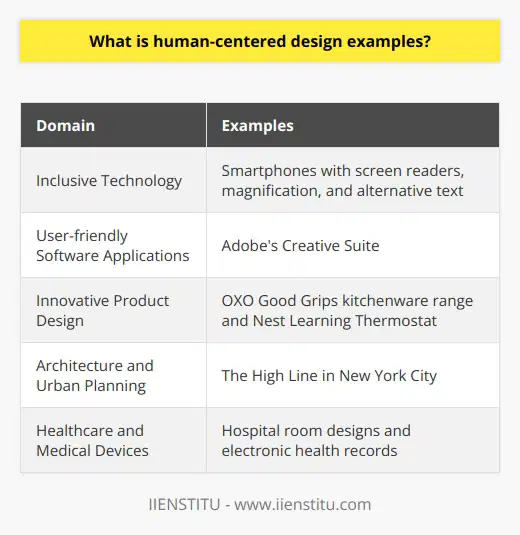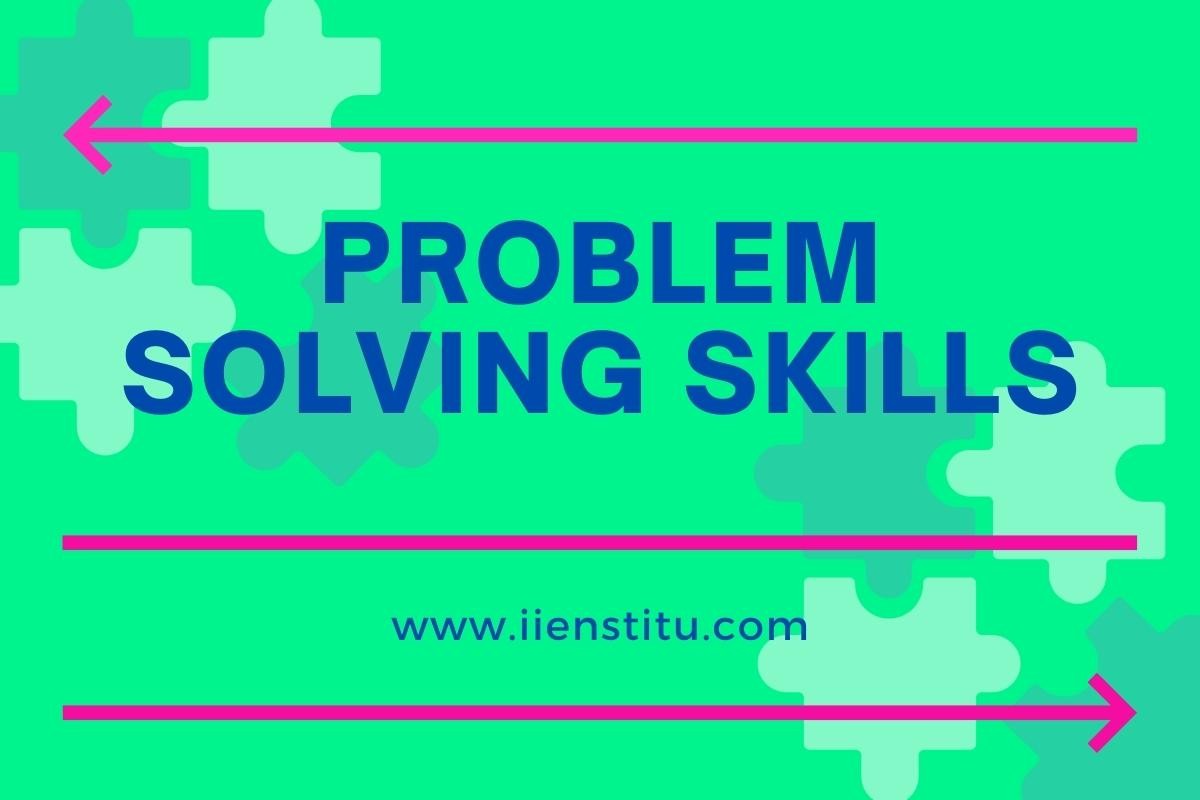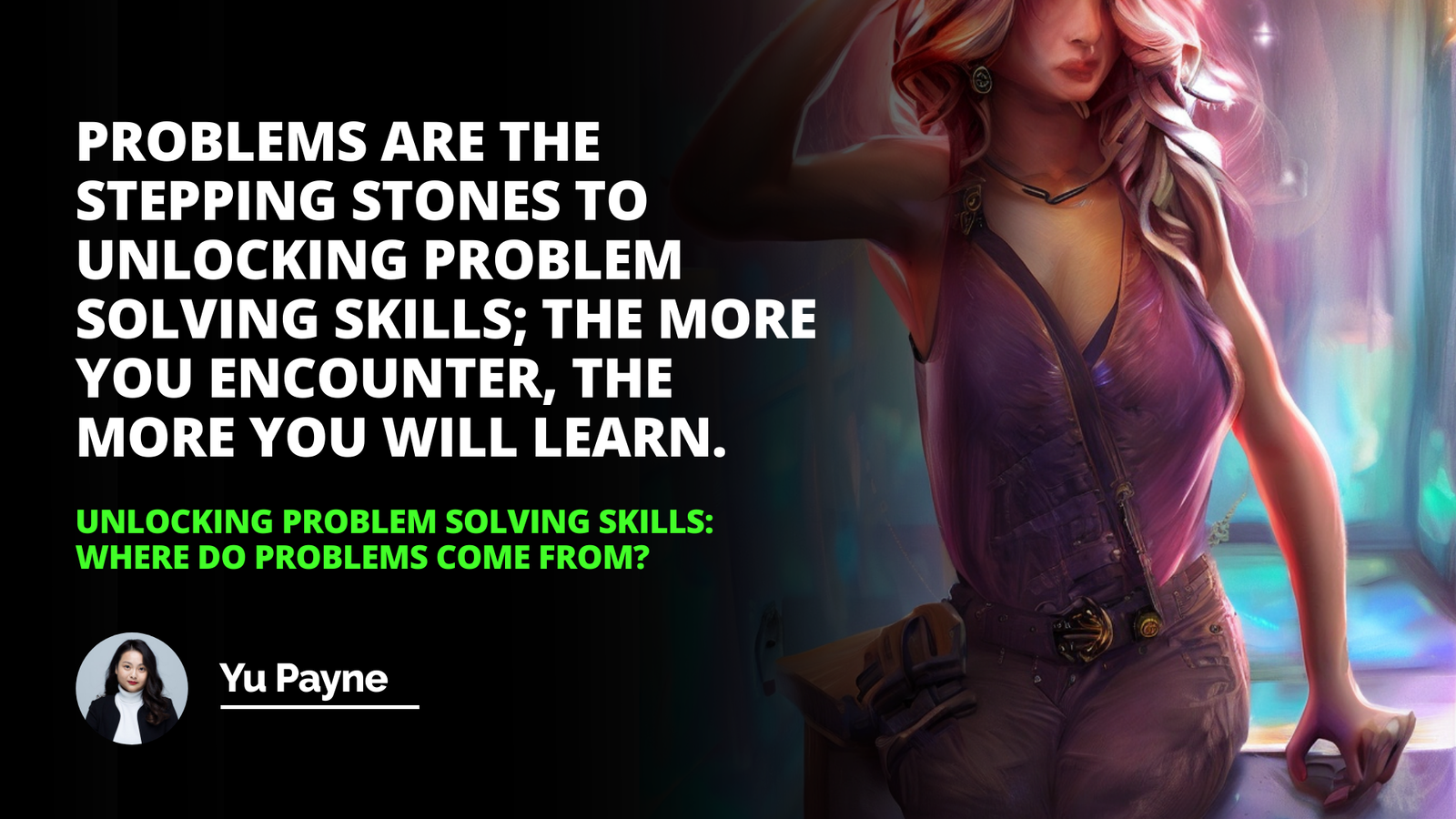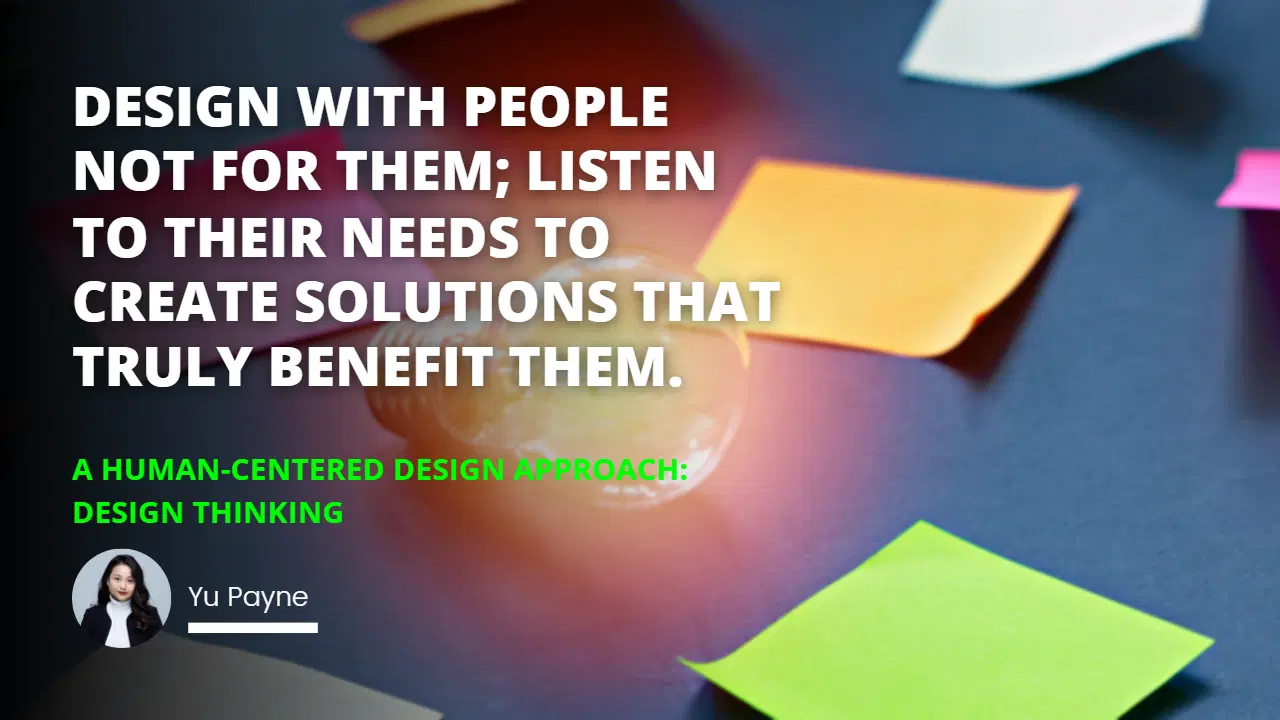
Walking through the bustling streets of my hometown, I often recall the old farmer's market where vendors and customers mingled with ease. The stalls were arranged just right, and everything seemed to flow naturally. But when the city decided to modernize it, the new design—though sleek and shiny—left everyone feeling lost in a maze. It was then that I realized the profound importance of designing with people, not just for them.
Benefits of Human-Centered Design
Design Thinking Framework
Best Practices
Embracing Human-Centered Design in Our Daily Lives
Human-centered design (HCD) isn't just a buzzword; it's a philosophy that places people at the heart of the design process. For centuries, humans have crafted tools and artifacts to improve our lives. Yet, how often have we truly considered how users interact with these creations or how they're impacted by them?
The Essence of Human-Centered Design
At its core, HCD is about empathy—understanding and addressing users' needs. Instead of designing in isolation, we immerse ourselves in the user's world, seeking to grasp their experiences, challenges, and aspirations. This approach not only leads to more innovative solutions but also ensures that products are intuitive and engaging.
I remember working on a project for a local library, aiming to redesign their digital catalog system. Rather than jumping straight into development, we spent weeks sitting with patrons, observing their interactions, and listening to their frustrations. It was eye-opening to see how a seemingly minor interface tweak could significantly enhance their experience.
Benefits of Putting People First
Adopting a human-centered approach brings a multitude of benefits:
1- Enhanced User Engagement: When products resonate with users' needs, they're more likely to engage and remain loyal.
2- Improved Usability: Designs become more intuitive, reducing the learning curve and increasing satisfaction.
3- Increased Innovation: By understanding real-world problems, we can devise creative solutions that might not be immediately apparent.
4- Better Decision Making: Grounding decisions in user research leads to more effective and impactful outcomes.
The Design Thinking Framework: A Roadmap to Innovation
One of the most powerful tools within HCD is the design thinking framework. This methodology encourages creative problem-solving through a user-centric lens.
The Five Steps of Design Thinking
1- Empathize: Step into the user's shoes. Engage with them to understand their needs, desires, and challenges.
2- Define: Articulate the core problem. Based on your insights, define the fundamental issues to address.
3- Ideate: Brainstorm potential solutions. Encourage free-thinking to generate a wide range of ideas.
4- Prototype: Create tangible representations. Develop prototypes to explore how solutions might work in practice.
5- Test: Evaluate and refine. Gather feedback from users to improve and iterate on your designs.
While collaborating with a non-profit organization, we applied this framework to develop an app that connects volunteers with community projects. Through prototyping and testing, we discovered that simplicity was key. Users preferred straightforward navigation over complex features, leading us to refine our design accordingly.
A Real-World Application: Optimizing Supply Chain Management
In the realm of business, HCD and design thinking can revolutionize operations. For instance, when seeking to optimize supply chain management process tips, companies can:
Design with people, not for them to listen to their needs to create solutions that benefit them.
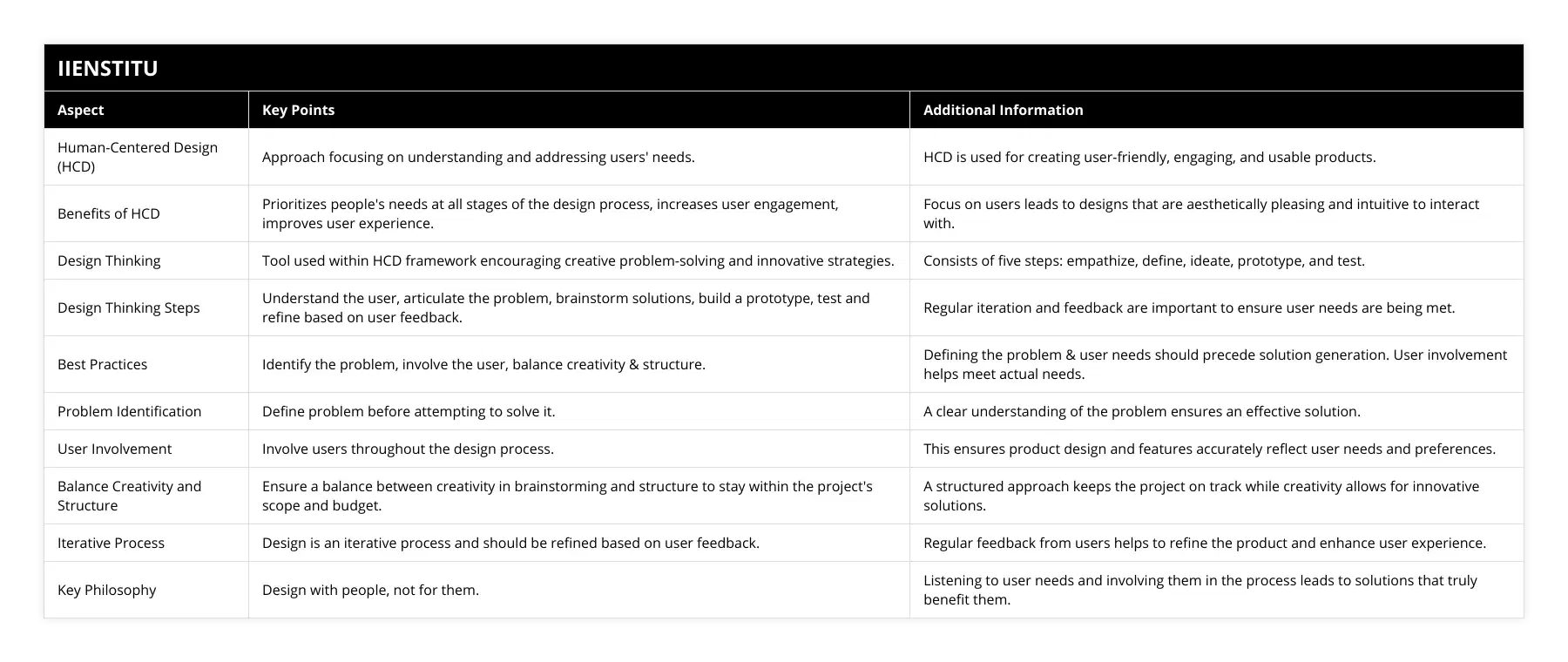
Empathize with employees on the ground to understand bottlenecks.
Define inefficiencies causing delays.
Ideate solutions, such as reorganizing warehouse layouts or implementing new technologies.
Prototype these changes in a controlled environment.
Test the impact, gathering feedback to refine the process.
By involving the very people who operate within the supply chain daily, organizations can create more efficient and satisfactory systems.
Best Practices for Successful Human-Centered Design
To truly harness the power of HCD and design thinking, certain best practices should be followed.
1. Involve Users Throughout the Process
From initial research to final testing, users should be at the heart of every decision.
Conduct Interviews: Engage users in conversations to gather deep insights.
Observe Interactions: Watch how they interact with existing products or systems.
Gather Feedback: Encourage honest opinions during testing phases.
2. Embrace a Collaborative Mindset
Diverse perspectives fuel innovation.
Cross-Functional Teams: Bring together individuals from different backgrounds.
Open Brainstorming Sessions: No idea is too wild during ideation.
Shared Goals: Ensure everyone is aligned on the user's needs.
3. Balance Creativity with Structure
While creativity is vital, maintaining a structured approach keeps projects on track.
Set Clear Milestones: Define objectives for each phase.
Regular Check-ins: Keep communication open to address challenges promptly.
Document Progress: Maintain records to track ideas and iterations.
On a project to redesign an educational platform, our team found that establishing a timeline with specific goals helped us stay focused. While we allowed space for creative exploration, the structure ensured we met our deadlines and produced a cohesive final product.
4. Prototype and Test Early
Don't wait for perfection. Early prototypes can provide invaluable insights.
Low-Fidelity Prototypes: Simple sketches or models can test concepts quickly.
Iterative Testing: Regular testing allows for continuous improvement.
User Feedback Loops: Constantly incorporate user insights into developments.
5. Keep the User's Context in Mind
Remember that users operate within specific environments and contexts.
Cultural Sensitivity: Designs should respect and reflect users' cultural backgrounds.
Accessibility Considerations: Ensure products are usable by people with diverse abilities.
Real-World Constraints: Factor in limitations users might face, such as technology access.
The Transformative Power of Human-Centered Design
HCD isn't limited to product design; it can transform entire systems and communities.
Take, for example, a project in a developing country where a team sought to improve access to clean water. Instead of importing a solution, they collaborated with local communities to understand their specific challenges and cultural practices. This led to the creation of a sustainable water filtration system that the community embraced and maintained.
Personal Reflections on HCD's Impact
Embracing HCD has changed not only how I approach projects but also how I perceive problems. It's taught me to:
Listen More Deeply: Truly hearing what users say, beyond just their words.
Remain Curious: Always ask questions and seek to understand the why behind behaviors.
Value Collaboration: Trusting in the collective wisdom of diverse teams.
Conclusion: Designing with People, Not Just for Them
When we prioritize human needs, we create solutions that are not only effective but also meaningful. Human-centered design and design thinking empower us to craft products and systems that genuinely enhance people's lives.
Reflecting on the modernized farmer's market, I can't help but think how different it might have been if the designers had involved the community. Perhaps the new design would have captured the essence of what made the market special in the first place.
In essence, design with people, not for them, and always listen to their needs to create solutions that truly benefit them.
References
Norman, D. A. (2013). The Design of Everyday Things. Basic Books.
Brown, T. (2009). Change by Design: How Design Thinking Transforms Organizations and Inspires Innovation. HarperBusiness.
Cross, N. (2011). Design Thinking: Understanding How Designers Think and Work. Berg Publishers.
Krippendorff, K. (2006). The Semantic Turn: A New Foundation for Design. CRC Press.
Curedale, R. (2013). Design Thinking: Process and Methods Manual. Design Community College Inc.
Frequently Asked Questions
What are the benefits of applying a Human-Centered Design Approach?
Human-centered design (HCD) use in product development has steadily increased in recent years as businesses recognize the importance and impact of customer engagement and user experience on their success. This article will explore the main benefits of incorporating HCD into the design process, focusing on how HCD provides a reliable and efficient way to create products that accurately and effectively meet customer needs.
HCD fosters a customer-centered approach that encourages businesses to prioritize customer objectives and requirements rather than simply jumping directly into the development process. A human-centered design approach enables designers to build customer empathy and develop an understanding of the customer's journey to create user experiences tailored to meet their customer base's needs and preferences. By focusing on customer needs and preferences, HCD enables companies to develop purposefully designed products to meet customer needs and expectations.
In addition to catering to customer needs, using HCD helps ensure product success by employing an iterative process that explores all possible solutions for each issue. By involving consumers in the design process, businesses can learn about their customer's needs and preferences, refine the designs based on customer feedback, and ultimately create products with increased usability, design refinement, and improved customer satisfaction.
HCD also enables businesses to identify and reduce risk and adjust their design processes quickly and efficiently. Applying HCD in the design process can identify potential risks, constraints, and challenges early on in the design process, allowing the team to develop strategies to mitigate or address the identified issues.
Overall, a human-centered design approach provides businesses with several clear advantages. By taking a customer-centered approach, companies can create a purpose-built product to meet customer needs and preferences while demonstrating a genuine understanding and appreciation for their customer base. HCD also helps reduce risk in the design process and efficiently identifies and adjusts the design process to create an effective and efficient end product. Ultimately, incorporating a human-centered design approach can ensure the success of product development, providing businesses with the assurance that their products meet customer needs and expectations.
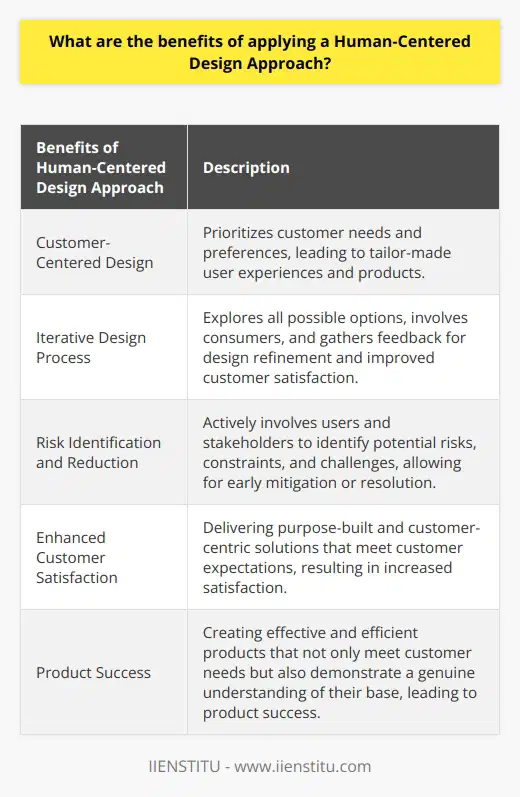
How does Design Thinking help organizations achieve their goals?
Design Thinking is an innovative and creative approach rapidly gaining attention in the business and corporate. It is a process of problem-solving that relies on intuition and empathy to develop viable solutions to complex problems. By utilizing a Design Thinking framework, organizations can tap into their creativity and use an iterative approach to refine solutions until they find a successful outcome continually.
Organizations must be able to anticipate and adapt to changes in the market to succeed. Design thinking can help them do just that. Design Thinking encourages organizations to focus on user needs instead of their motivations. By understanding customers' needs, organizations can better develop solutions tailored to meet these needs. This can help organizations meet their goals more timely and efficiently.
Furthermore, design thinking can aid organizations in understanding their stakeholders and the connections between them. This can help organizations identify and bridge communication gaps, as well as develop solutions that are designed to satisfy all stakeholders. This can help organizations achieve overall objectives faster and with greater effectiveness.
Additionally, design thinking can help organizations address complex problems by allowing them to break down problems into smaller, manageable parts. This creative problem-solving can enable organizations to approach issues from multiple perspectives, ultimately improving problem-solving performance. Organizations can benefit from increased collaboration among departments by taking an iterative approach.
To conclude, design thinking gives organizations the tools to identify, refine, and solve complex problems. By focusing on user needs, communicating with stakeholders, and breaking down complex problems into smaller, more manageable ones, organizations can tap into their creativity and find solutions to achieve their goals.
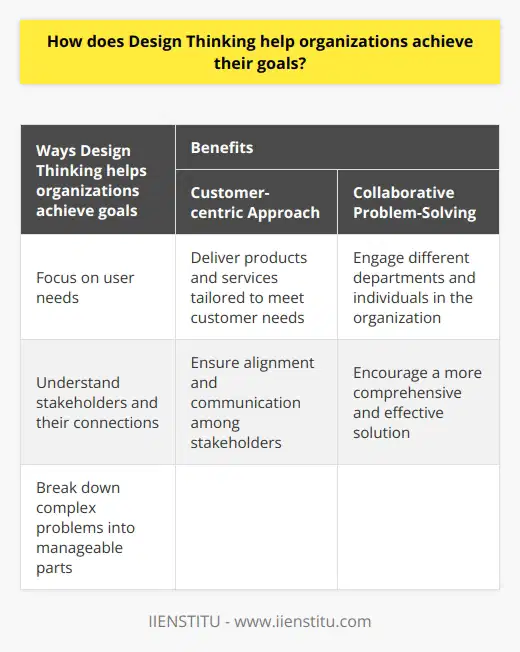
What tools or techniques are commonly utilized in Human-Centered Design?
Human-Centered Design (HCD), or user-centered Design, is the process of designing products and services that focus on the user's needs while ensuring they are of great use, economical and accessible. In the HCD process, designers use various tools and techniques, such as user research, collaboration, and prototyping, to understand how solutions could best meet user needs.
User Research
One of the most critical steps in the HCD process is conducting user research. User research is the process of understanding target users' needs, motivations, and behaviors by researching, observing, and testing the user. It is done to gather data that can help determine what types of features and functions users find valuable, identify existing solutions that can be used for inspiration, and inform HCD design processes. User research can be done through surveys, interviews, focus groups, contextual inquiry, usability testing, and analytics.
Collaboration
Collaboration is another vital part of the HCD process. It involves bringing multiple disciplines together from different departments or organizations to work towards creating a valuable and desirable solution for the user. In addition, it helps to get different perspectives and skills to the design process. Brainstorming, problem-solving, and creativity techniques are all used for collaboration during the HCD process.
Prototyping
Prototyping is a critical part of the HCD process. Prototyping is the process of creating a model or an interactive simulation of a product to explore the concept and test out ideas. It allows the HCD team to quickly explore different design solutions and get feedback from the design team or potential users. The prototypes can then refine and improve the Design before fully developing the product.
Human-Centered Design is a process that puts the user's needs first to create products and services that meet them. To complete a great user experience, designers use user research, collaboration, and prototyping tools. It is a highly iterative process that requires understanding user needs, an iterative approach to Design, and cooperation among multiple disciplines.
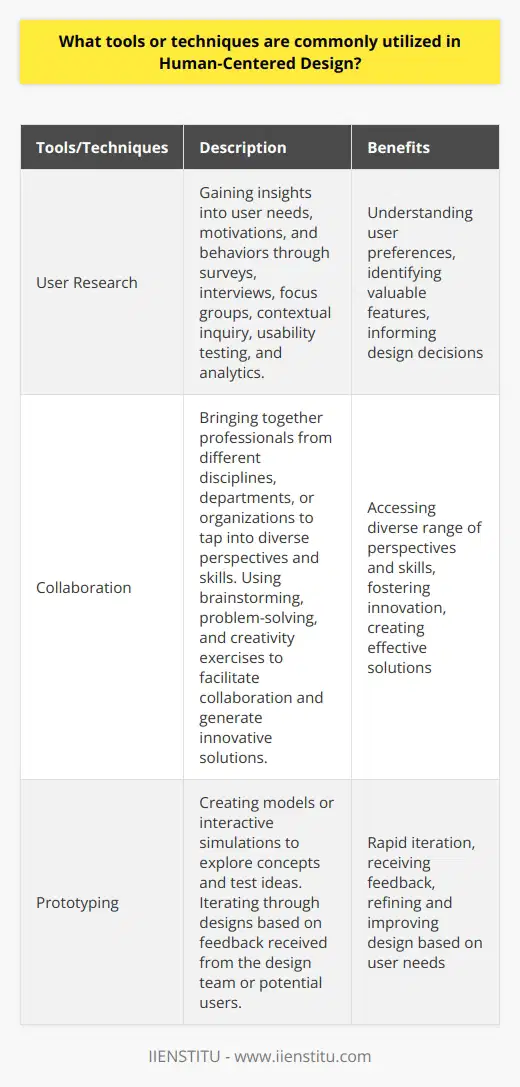
What is the relationship between human-centered design thinking and innovation?
Human-Centered Design and Innovation
Understanding the Concept
The relationship between human-centered design thinking and innovation lies in their shared focus on understanding and addressing user needs. Human-centered design (HCD) is a problem-solving approach that involves empathy, experimentation, and iteration, with the primary goal of creating solutions that are tailor-made for the people who will use them. By placing users at the core of the design process, HCD ensures that their experiences, preferences, and concerns are thoroughly considered in the development of new products, services, or systems.
Innovation and Human-Centered Design
Innovation is the process of creating something new, valuable, and useful, often by combining existing ideas or technologies in novel ways. HCD is a powerful driver of innovation since it provides a systematic and adaptable framework for generating ideas that cater to the specific needs and aspirations of users. Through empathy, designers can discover latent or unmet needs, providing opportunities for breakthrough innovations that may otherwise go unnoticed.
Mutual Reinforcement
Moreover, human-centered design thinking and innovation mutually reinforce one another. HCD offers insights that can inspire innovative solutions, while the development and deployment of innovative products or services can, in turn, inform and refine the HCD process. As designers experiment with different ideas and prototypes, they continuously learn more about user needs, preferences, and reactions – leading to improved iterations that can push the boundaries of innovation further.
Contribution to Various Fields
Both HCD and innovation have been instrumental in driving advancements across diverse fields, such as product design, technology, education, healthcare, and more. By aligning the design process with users' perspectives and aspirations, organizations can foster the development of innovative solutions that improve user experience, increase engagement, and maximize the positive impact of their offerings.
Importance of Collaboration
Crucial to this relationship is the promotion of interdisciplinary collaboration involving professionals from different backgrounds, expertise, and perspectives. Such collaboration enriches the design process by bringing together varying viewpoints, fostering open dialogue, and encouraging the exploration of unexpected connections, which can fuel innovation.
In conclusion, human-centered design thinking and innovation are closely intertwined, with the former providing a lens that directs the latter towards users' needs and aspirations. By fostering empathy, collaboration, and iteration, this relationship enables the creation of innovative solutions that cater to diverse needs and drive progress across numerous fields.

How can human-centered systems thinking be applied to address complex societal issues?
Understanding Complex Societal Issues
To address complex societal issues, human-centered systems thinking can be applied in various ways. By examining systems holistically and prioritizing human experience, this approach encourages a deeper understanding of the interdependencies and dynamics that underlie these problems.
Working With Stakeholders
One way to apply human-centered systems thinking is through meaningful collaboration with stakeholders. Engaging diverse individuals and organizations helps capture a variety of perspectives, which can then be synthesized to generate a comprehensive view of the issue at hand. In turn, this allows for more informed and effective decision-making.
Enabling Empathy and Contextual Understanding
Another aspect of human-centered systems thinking focuses on developing empathy for the people affected by societal problems. By delving into the values, beliefs, and experiences of diverse populations, we can create nuanced models of the system’s components and interactions. This contextual understanding facilitates the design of interventions and solutions that can adapt to evolving circumstances.
Employing Iterative Processes
In applying human-centered systems thinking, it is also vital to recognize that complex issues are constantly evolving. Therefore, iterative processes should be employed to continually update and fine-tune our understanding of problems and solutions. This flexibility allows us to adapt to emerging challenges, fostering more resilient and sustainable outcomes.
Fostering Interdisciplinary Approaches
Lastly, complex societal issues often straddle multiple disciplines, and human-centered systems thinking advocates for an interdisciplinary approach. Drawing from diverse fields, such as sociology, psychology, and environmental science, not only facilitates a broader understanding of the problem but also supports the creation of innovative and integrative solutions.
In conclusion, human-centered systems thinking can be instrumental in addressing complex societal issues by promoting meaningful stakeholder engagement, developing empathy, embracing iteration, and fostering interdisciplinary collaboration. By focusing on the human experience at the core of these problems, this approach can nurture more effective and resilient solutions that contribute to a more just and equitable society.

In what ways does the implementation of a human-centered approach impact the user experience of a product or service?
Incorporating Empathy in Design
The implementation of a human-centered approach significantly impacts the user experience of a product or service by paying close attention to users' needs, preferences, and emotions. By actively involving users in the design process, designers can develop solutions that are not only functional but also empathetic, creating a more profound connection between the user and the product or service. This can lead to increased user satisfaction and loyalty, ultimately resulting in the long-term success of a product or service.
Understanding Users' Needs and Preferences
Human-centered design requires extensive research into users' behaviors, motivations, and preferences to make informed decisions in designing products or services. Direct observation, interviews, and surveys are crucial for gathering valuable information about users' needs and desires. Designers can use these insights to create tailored solutions that address specific pain points and drive meaningful engagement, leading to a more positive user experience.
Focusing on Accessibility and Inclusivity
A key aspect of human-centered design is to ensure that products and services cater to a diverse range of users, including those with disabilities. By incorporating accessibility and inclusivity from the outset, designers can create experiences that accommodate a wide variety of users, regardless of their abilities. This not only enhances the usability of the product or service but also demonstrates a company's commitment to social responsibility and ethical practices.
Enhancing Emotional Connections
By emphasizing emotional experiences, human-centered design creates stronger connections between users and products or services. By evoking positive emotions, such as joy, trust, and delight, designers can foster lasting relationships with users that extend beyond the functionality of the product or service. These emotional connections can help build brand loyalty and encourage long-term engagement, making human-centered approaches increasingly essential for businesses aiming to differentiate themselves in the market.
Promoting User Autonomy and Control
As the need for personalized experiences grows, human-centered design becomes more vital to product or service development. By giving users the ability to customize their experiences, designers can empower users, enhance their sense of autonomy, and make the product or service more appealing to diverse audiences. These tailored experiences contribute to increased user satisfaction and retention, which are essential markers of success for businesses.
In summary, adopting a human-centered approach has profound implications on the user experience of a product or service. It involves understanding users' needs, focusing on accessibility and inclusivity, enhancing emotional connections, and promoting user autonomy and control. With these considerations in mind, businesses can develop products and services that truly resonate with their users, ensuring sustained success in today's competitive landscape.

What is the human-centered approach in design thinking?
Human-Centered Approach in Design Thinking
Understanding the Concept
The human-centered approach in design thinking refers to a problem-solving strategy that prioritizes the needs, emotions, and behaviors of end users. This approach ensures that the eventual product or service aligns with their expectations, desires, and abilities, consequently leading to a greater user experience and successful outcomes.
Empathy as the Foundation
A fundamental aspect of the human-centered approach is the emphasis on empathy. Designers put themselves in the shoes of the users, striving to understand their perspectives and experiences. This empathetic understanding forms the basis for identifying users' problems, needs, and preferences, making it essential for effective design thinking.
Iterative Design Process
An iterative process characterizes the human-centered approach in design thinking. Designers engage in several cycles of ideation, prototyping, and testing, allowing them to refine their solutions in response to user feedback continuously. This constant iteration ensures that the final product or service caters to the users' evolving needs and preferences.
Collaboration and Interdisciplinarity
The human-centered approach embraces collaboration and interdisciplinarity, bringing together diverse perspectives, expertise, and methods. This multidisciplinary team offers a well-rounded understanding of the problem at hand, leading to more innovative and relevant solutions that address users' needs.
Contextualizing Solutions
Lastly, the human-centered approach recognizes the importance of context in determining the effectiveness of a solution. Designers consider factors such as culture, environment, and social norms, ensuring that their solution aligns with the users' unique circumstances. This contextualization leads to solutions that are not only useful and usable but also meaningful and desirable for users.
In conclusion, the human-centered approach in design thinking emphasizes the primacy of users, positioning their needs, desires, and abilities at the center of the problem-solving process. By prioritizing empathy, iteration, collaboration, interdisciplinarity, and contextualization, designers can create innovative solutions that enhance user experiences and promote successful outcomes.

What are the 4 principles of human-centered design?
Understanding the Principles of Human-Centered Design
To address the question of what constitutes the four principles of human-centered design, it is crucial to first grasp the concept itself. Human-centered design is a problem-solving approach that involves prioritizing the needs, preferences, and limitations of users throughout the design process. This design methodology ensures the development of highly usable and accessible products, emphasizing cooperation between designers and users from the initial stages.
Empathy: At the Core of the Design
The first principle of human-centered design is empathy. Empathy involves understanding and relating to people's emotions, inspirations, and values. By adopting empathy in the design process, designers can better comprehend users' particular needs, ensuring a solution that is attuned to their specific requirements. This connection between the designer and the user is essential for creating products that genuinely meet the targeted audience's demands.
Inclusive and Diverse Design Process
The second principle highlights the importance of inclusivity and diversity. This principle emphasizes the need to involve different perspectives and backgrounds during the design process to create well-balanced products. Collaborating with a diverse group of stakeholders, such as users, developers, and designers, helps in considering various viewpoints and identifying unforeseen issues. Consequently, this enables the creation of more comprehensive and adaptable solutions that cater to a broader audience.
Iterative and Flexible Approach
Adopting an iterative and flexible approach constitutes the third principle of human-centered design. This method involves frequent evaluation and revisions of design as it progresses, allowing designers to refine it based on user feedback continuously. By employing this iterative technique, products are continually assessed and updated according to emerging needs, leading to more practical and user-friendly designs.
Participatory Design and Co-creation
Finally, the fourth principle is participatory design, which involves cooperation between designers and users in the creation process. Through active user involvement, the design is better tailored to their necessities and preferences. This co-creation process enables designers to gain valuable insights directly from the users, ensuring solutions that are both relevant and effective.
In conclusion, the four principles of human-centered design—empathy, inclusive and diverse design process, iterative and flexible approach, and participatory design—contribute to the development of user-focused and accessible products. Implementing these principles in the design process paves the way for more purposeful and robust solutions that cater to the diverse and evolving needs of users.
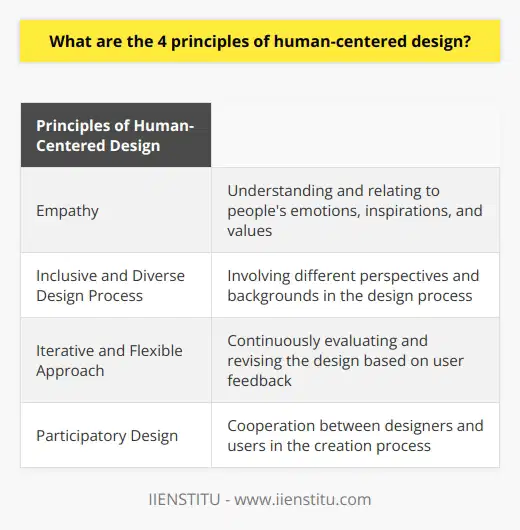
Which component of design thinking is human-centered?
Understanding Human-Centered Design Thinking
One central component of design thinking that focuses on the human aspect is the human-centered design approach. This methodology emphasizes empathy and iterative learning in the design process, resulting in products or solutions that cater directly to the needs, desires, and experiences of the end-users.
Empathy in Design
Empathy is key in understanding the perspectives, emotions, and motivations of the individuals who will interact with the final product or solution. Designers prioritize users' needs and desires by engaging in active listening, observation, and reflection, leading to informed problem-solving. Truly understanding people's daily struggles and challenges allows designers to create meaningful solutions that genuinely improve human experiences.
Iterative Learning Process
Human-centered design relies on multiple iterations and continuous refinement, leading to better results. Designers benefit from using an agile approach, testing prototypes rapidly, and gathering feedback from end-users throughout the development process. This helps ensure that the final product has been rigorously assessed, challenged, and improved, resulting in a solution that effectively addresses users' needs.
Collaborative Decision-Making
In human-centered design thinking, collaboration among stakeholders is essential for success. By inviting diverse viewpoints and fostering cross-disciplinary cooperation, designers can challenge their assumptions and deliver more innovative, user-friendly solutions. Collaboration also tends to create an empowering environment where team members are more willing to take risks, enabling them to explore and refine new ideas with confidence.
Conclusion
Ultimately, human-centered design thinking is an invaluable approach that focuses on empathy, iterative learning, and collaboration. By placing end-users at the forefront of the design process, designers can create products and solutions that improve human experiences and address real-world needs. In an increasingly complex and interconnected world, this human-centered approach is crucial for fostering innovation and leaving a positive, lasting impact on people's lives.

Who said that design thinking is a human-centered approach?
Origin of 'Design Thinking as a Human-Centered Approach'
The concept of design thinking as a human-centered approach originated from the works of Herbert Simon, a Nobel Prize-winning economist, and psychologist. In his seminal book, 'The Sciences of the Artificial,' published in 1969, Simon emphasized the importance of empathizing with users and understanding their needs and desires when solving complex problems.
Influence of IDEO and Tim Brown
The phrase 'design thinking is a human-centered approach' gained significant traction with the work of IDEO, a global design and innovation consultancy. Tim Brown, the CEO and president of IDEO, has been highly influential in spreading this concept through his writings, such as his 2008 article, 'Design Thinking,' published in the Harvard Business Review. Brown highlighted the significance of empathy, experimentation, and iteration in design thinking.
Role of Stanford University's d.school
Stanford University's Hasso Plattner Institute of Design, also known as the d.school, has also played a critical role in popularizing design thinking as a human-centered approach. Co-founded by David Kelley, a celebrated design thinker and founder of IDEO, the d.school has become a leading institution in teaching design thinking methodologies that prioritize human needs and experiences.
Overall, multiple influential individuals and organizations have contributed to the idea of design thinking as a human-centered approach. While Herbert Simon first introduced the concept, it was further developed and popularized by Tim Brown, IDEO, and Stanford University's d.school. These pioneers have stressed the importance of empathy, understanding users, and focusing on human experiences as the core principles of design thinking.
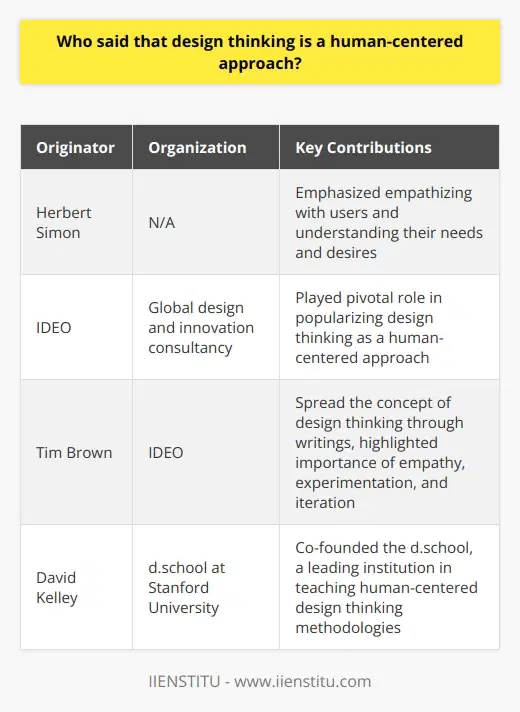
What are the 5 steps of human-centered design?
Understanding Human-centered Design
Human-centered design is an approach that starts with the people being served and ends with innovative solutions tailored to their needs. There are five main steps in the human-centered design process, including empathy, define, ideate, prototype, and test.
Empathy: Building a Personal Connection
The first step in human-centered design is empathy. Designers should engage with users by listening to their stories, observing their interactions, and immersing themselves in their experiences. Doing so will help the design team to build a personal connection and understand the users' needs from their perspectives.
Define: Identifying Key Issues
The second step is defining the core problem faced by the people. The knowledge gained from empathizing helps in identifying the problem area that the design team wants to address. Clearly stating the problem helps to maintain focus and provides a solid foundation for ideation.
Ideate: Generating Creative Solutions
The third step in the process is ideation. Here, designers are encouraged to brainstorm and generate diverse solutions to address the defined problem. The focus should be on creative, innovative, and original ideas, which will be later refined and assessed for feasibility.
Prototype: Creating Tangible Representations
The fourth step in human-centered design is prototyping. Designers need to create tangible representations of their ideas like physical or digital models. Prototypes should be inexpensive and easy to alter so they can be refined through the iterative process. This step helps to visualize and communicate potential solutions before implementation.
Test: Refining Solutions through Feedback
The last step in the human-centered design process is testing. In this phase, the design team shares their prototypes with end-users for feedback. Incorporating this feedback allows the team to iterate and refine the design to ensure it truly addresses the users' needs. Testing is essential to validate and improve the final design.
Overall, human-centered design focuses on understanding and addressing the needs, desires, and emotions of the users. By following these five steps, designers can develop innovative solutions that significantly improve the lives of the people they serve.

What is human-centered design examples?
Defining Human-Centered Design
Human-centered design (HCD) is an approach that places the end-user at the core of the design process. It involves understanding user needs, preferences, and emotions, and leveraging this knowledge to create functional, enjoyable, and accessible products, services, and spaces. Here, we discuss various examples of HCD in action.
Inclusive Technology
Many technological devices and platforms are designed with human-centered principles. For instance, smartphones incorporate accessibility features such as screen readers, magnification, and alternative text to cater to users with visual or hearing impairments. Similarly, voice-activated virtual assistants like Siri, Alexa, and Google Assistant enable users with mobility issues to interact with technology using their voices, ensuring that these devices remain accessible and functional for a wider audience.
User-Friendly Software Applications
In the realm of software applications, human-centered design plays a key role in shaping the user experience. Developers prioritize usability, intuitiveness, and logical navigation when designing applications to ensure that users can effortlessly interact with the program and achieve their intended tasks efficiently. For example, Adobe's Creative Suite incorporates HCD principles by presenting crisper, clean interfaces with well-organized tools and streamlined workflows, allowing users to focus on their creative process instead of struggling with complicated user interfaces.
Innovative Product Design
Human-centered design is prominent in the development of innovative, practical, and aesthetically pleasing products. Notable examples include the OXO Good Grips kitchenware range, which boasts ergonomic designs, non-slip grips, and easy-to-read measurement markings, catering to users with arthritis and other mobility limitations. Similarly, the Nest Learning Thermostat features a simple, minimalist design with a user-friendly interface, making it easier for users to manage their home's temperature and energy consumption.
Architecture and Urban Planning
In the field of architecture and urban planning, HCD informs the creation of functional and engaging spaces. This includes designing public spaces that promote social interaction, greenery, and walkability, as well as buildings that maximize natural light and prioritize accessibility for people with different physical abilities. For example, the High Line in New York City is an urban park built on an elevated railway that combines greenery, art installations, and seating areas to create an inviting space catering to diverse user needs.
Healthcare and Medical Devices
Human-centered design is also applied in the healthcare sector to improve patient experience and medical outcomes. For instance, the design of hospital rooms has evolved to accommodate better patient care, privacy, and natural light. Additionally, medical devices such as electronic health records have been designed with user experience in mind, making it easier for healthcare professionals to navigate and access important patient information.
In conclusion, human-centered design manifests across various domains, including technology, software applications, product design, architecture, and healthcare, ultimately benefiting end-users by considering their needs and preferences in the design process.
